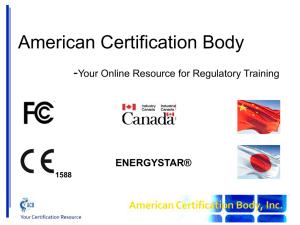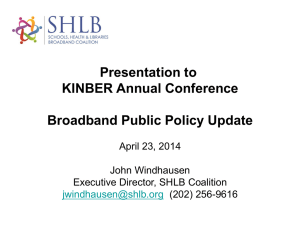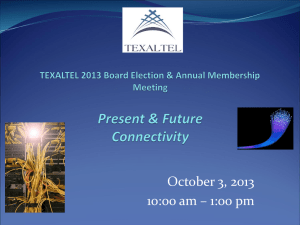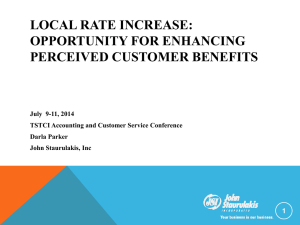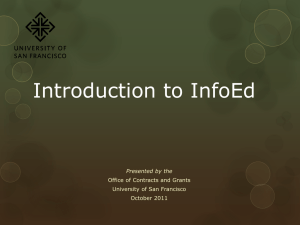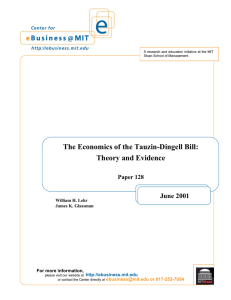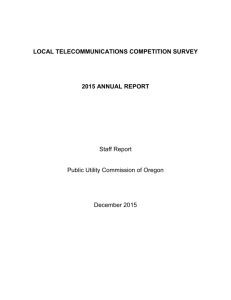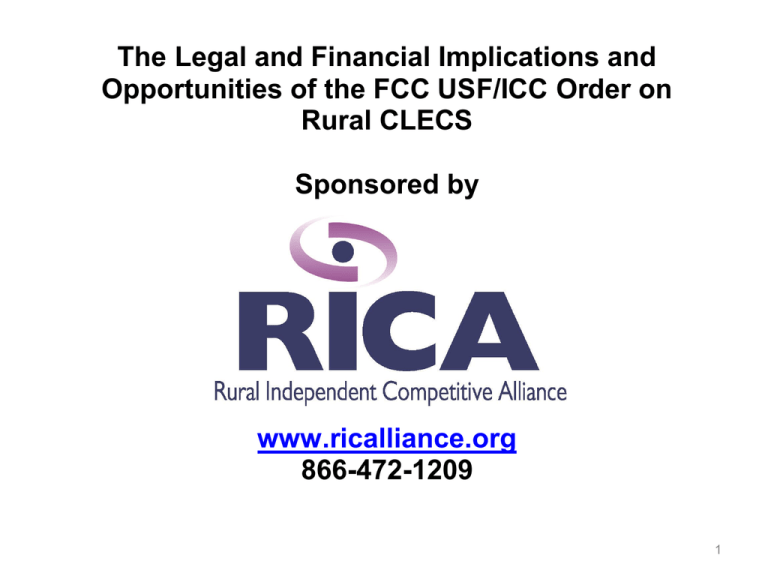
The Legal and Financial Implications and
Opportunities of the FCC USF/ICC Order on
Rural CLECS
Sponsored by
www.ricalliance.org
866-472-1209
1
FCC ICC/USF ORDER:
APPEALS AND OPTIONS
THE FUTURE OF RURAL CLECS
2
IN RE FCC 11-161
US COURT OF APPEALS FOR 10TH CIRCUIT
WHY SHOULD RURAL CLECS CARE?
• FCC Order 11-161 transitions CLECs to sole
reliance on end user revenues
– Inter- and intrastate access transition to Bill & Keep (i.e.
“$0.00”) over 9 years ; ILECs get temporary support,
CLECs do not.
– CLEC USF Revenue frozen and phased out; price cap
ILECs get USF support for broadband, CLECs excluded
for at least five years
3
Overview of Order
INTERCARRIER COMPENSATION
1. Inter- and intrastate terminating access
frozen and converted to reciprocal
compensation
2. Default rate of zero (“Bill & Keep”)
prescribed after transition
3. “Recovery Mechanism” created for ILECs
a. Access Recovery Charge (“ARC”) to end-users
b. USF (CAF) support for excess over ARC on
declining separate schedules for Price Cap
and Rate of Return ILECs
4
Overview of Order
UNIVERSAL SERVICE SUPPORT
1. Connect America Fund (“CAF”) replaces current USF
after transition.
2. Voice remains only supported service, but receipt of
support conditioned on provision of Broadband per
technical specs.
a. Phase I in Price Cap territories
i. Frozen 2011 USF level + $300M
ii. Distributed based on current model at holding
company level.
iii. If accept support, provide BB at 4/1 to one
subscriber for each $775 received
5
Overview of Order
UNIVERSAL SERVICE SUPPORT (Cont’d)
3. Phase II in Price Cap territories
a. Model predicts support required by unserved areas
b. If elect support, must commit to provide BB to all high
cost (except very high cost) areas in state within 5
years.
c. After 5 years, support awarded by competitive
bidding.
4. CAF support for Rate of Return
a. Required to provide BB on “reasonable request”
b. Existing support substantially reduced by “reforms”
c. Further notice explores BB focused CAF for RoR
6
Overview of Order
UNIVERSAL SERVICE SUPPORT (Cont’d)
5. Very High Cost Areas
6. Mobility Fund
• Phase I Auction Sept. 27, 2012
• Phase II
7. Reconsideration Petitions
• RICA reply re para. 150 “unsubsidized
competitor”
• Third Order released May 15, 2012
8. Decision on FNPRM Issues pending
9. Bureau Implementation Orders
• Regression Model Revised
• Waivers pending
7
Overview of Order
CLEC Specific Provisions
1.
ICC
a.
b.
2.
Terminating access rates phased out over 9 years beginning
July 1, 2012
CLECs excluded from all aspects of Recovery Mechanism
USF
a. Identical support based USF frozen and phased out over five
years.
b. Price cap carriers have de facto Right of First Refusal during
Phases I & II of CAF
c. CLECs can bid for support in Price Cap territory if ILEC
refused Phase II support and after 5 years
d. No mechanism for CLEC support in RoR areas.
8
Parties and Schedule of Appeal
1.
Court and Parties
a.
b.
2.
All appeals consolidated by lottery at10th Circuit in Denver,
26 Petitioners, 21 Interveners: State Commissions,
Consumer Advocates, ILECs (Price Cap, RoR including Tribal
Owned), CLECs, Wireless
Probable Schedule
a. Briefing schedule to be adopted by court on motion of
parties
i. Parties required to cooperate on consolidated briefs
ii. Expect main and supplemental briefs
b. Argument after completion of briefing schedule
c. Decision 3 -12 months after argument
9
Scope of Review
1. Court must defer to agency per “Chevron”
a. Follow terms of unambiguous statute
b. Reasonable interpretation of ambiguous statute
2. Basis for review
a. Administrative Procedure Act
b. Supreme Court Precedent
10
Administrative Procedure Act
The reviewing court shall hold unlawful and set aside
agency action, findings, and conclusions found to be:
A. arbitrary, capricious, an abuse of discretion, or
otherwise not in accordance with law;
B. contrary to constitutional right, power, privilege, or
immunity;
C. in excess of statutory jurisdiction, authority, or
limitations, or short of statutory right;
11
Supreme Court Precedent
• Reviewing court may not substitute its judgment for that of the
agency, but may find decision arbitrary and capricious if the
agency has committed a “clear error of judgment”
• Review limited to whether the agency articulated a rational
connection between the facts found and the decision made.
• Action is arbitrary and capricious if agency has relied on factors
which Congress has not intended it to consider, entirely failed to
consider an important aspect of the problem, offered an
explanation for its decision that runs counter to the evidence
before the agency, or is so implausible that it could not be
ascribed to a difference in view or the product of agency
expertise.
• Agency’s explanation must be “sufficient to enable us to conclude
that it was the product of reasoned decision making.”
• Reasoned decision making requires the agency to acknowledge
and provide an adequate explanation for its departure from
established precedent.
12
Issues before the Court
General ICC Issues
1. Neither the record nor the FCC’s explanation support abandonment of
“calling party pays.”
2. Order contrary to Sections 251, 252 and 254
a)
b)
c)
No authority to treat inter and intrastate terminating access as reciprocal
compensation.
If FCC does have authority to treat as reciprocal compensation, FCC
prescription of a specific rate unlawfully preempts state authority to
arbitrate interconnection agreements.
If FCC does have authority to prescribe specific rate, it must comply with
the “additional cost” standard of the act and it has no record establishing
the cost of call termination.
3. FCC lacks authority to preempt state regulation of originating access.
4. Order deprives RoR carriers of a reasonable opportunity to recover
their lawful and prudent investment and expenses.
5. Order camouflages its effect of creating vast windfall for ATT/Verizon.
13
Issues before the Court
General USF Issues
1. The Act does not permit the FCC to condition receipt of
support for a “supported” telecommunications service
upon the provision of an unsupported information service.
It cannot do by indirection what it is prohibited from
doing by direction.
2. The decision to limit CAF support to a budget based on
the amount provided by current contributions to “legacy”
USF is without a rational basis.
a.
b.
c.
No determination of how much support is sufficient and predictable in
order to make rural service and rates reasonably comparable to
urban.
No rational relation between contribution amounts available from
declining base of interstate voice service users and that which could
be raised by customers of broadband service.
It is irrational to presume that support can be provided for expanded
investment necessary to provide BB to unserved areas and continue
existing voice service while simultaneously increasing total amount of
support
14
Issues before the Court
General USF Issues (Cont.)
1. The decision ultimately to use competitive
bidding to award support fails to address the
multiple, substantial objections in the record.
2. There is no basis in the Act or the record for
exclusion of very high cost areas from support
necessary to enable reasonably comparable
service and rates. Record indicates satellite
service is not reasonably comparable.
3. The exclusion of areas with “unsupported”
competition is not rational or based on record
support.
15
Issues before the Court
RICA Specific ICC Issues
A. The recovery mechanism treats ILECs and CLECs
differently without adequate justification by
providing USF (CAF) support for lost access revenues
to ILECs but not the CLECs competing with them.
B. The elimination of access revenues makes cost
recovery impossible while greatly benefiting two
largest ILECs.
16
Issues before the Court
RICA Specific USF Issues
The exclusion of CLECs from eligibility for CAF support violates
the Act, the FCC adopted principle of competitive neutrality and
is without basis in the record.
a)
Major Purpose of the ‘96 Act to promote local competition,
CLECs were made eligible for USF (including mandatory ETC
designation in non-rural areas) in order that they could
compete with ILECs receiving support.
b) FCC action removes support from entities that have
demonstrated intent and ability to serve rural areas.
c) No record support for FCC argument that Price Cap carriers
voice networks provide base to extend BB to unserved areas.
d) FCC actions designed to eliminate small companies in interest
of supposed efficiencies of large carriers.
17
RICA Docketing Statement Issues
1. Did the FCC exceed its authority in requiring
entities to provide Broadband Internet Access as
a condition of receipt of universal service
support for the Title II voice services they
provide?
2. Is [the Right of First Refusal] contrary to the
principle of competitive neutrality adopted by
the Commission, and/or otherwise unlawful?
18
RICA Docketing Statement Issues
(Cont’d)
3. Did the FCC exceed its authority or otherwise act
arbitrarily by ending the historic "called party pays"
paradigm and instead designating terminating access
as reciprocal compensation?
19
RICA Docketing Statement Issues
(Cont’d)
4. Does … Bill and Keep … violate the requirement of
Section 252(d)(2) of the Act that reciprocal
compensation must allow for the recovery of the
"additional costs" of terminating calls and/or
arbitrarily disregard objections that it had not
ascertained the underlying costs of call termination?
20
RICA Docketing Statement Issues
(Cont’d)
5. Was order provid[ing] CAF support for ILECs’ lost
interstate and intrastate access revenues, but not for
CLEC lost revenues, either violative of the 1996 Act,
an arbitrary departure from its findings in the same
order that CLECs lack market power, … or otherwise
in arbitrary disregard of the constraints on rural
CLECs?
21
RICA Docketing Statement Issues
(Cont’d)
6. Did the FCC exceed its authority by preemptions of
state commission authority to designate ETCs or to
set rates for intrastate access and reciprocal
compensation?
7. Is the FCC Order’s conclusion that the revised rules
will result in voice and broadband services that are
reasonably comparable to urban service at
reasonably comparable rates supported by
substantial evidence …?
22
RICA Docketing Statement Issues
(Cont’d)
8. [Was] the FCC’s decision establishing a budget for the
CAF based solely on the maximum perceived
contribution from declining voice service revenues,
unsupported by substantial evidence, illogical or
otherwise reflective of an arbitrary failure to give
reasoned consideration to expanding the revenue
contribution base?
23
RICA Docketing Statement Issues
(Cont’d)
9. Did the FCC decision to utilize competitive bidding to
determine which carrier will receive CAF support in a
given area run contrary to law, and/or arbitrarily
disregard evidence that competitive bidding would
not work, and/or lack substantial evidence to support
it?
24
Questions?
25
Needles & Haystacks
“The NEW Competitive Normal”
Presented by CHR Solutions
Kent Larsen – Senior Vice President, Financial Services
© CHR Solutions. All Rights Reserved.
Yesterday – The ILEC World
• Monopoly
– If not us, then who?
• Enabling Networks
– Expensive
– First and Only
• Rate of Return
– Profits tied to Network Investments
© CHR Solutions. All Rights Reserved.
27
Yesterday & Today – The CLEC World
• Monopoly Competition
– If not us, then who? Maybe not everywhere but it’s there
• Enabling Networks Competing Networks
– Expensive Sometimes Cheaper, More Valued
– First and Only Many
• Rate of Return Low Cost Provider Wins
– Profits tied to Network Investments Profits tied to Operating
Efficiency
© CHR Solutions. All Rights Reserved.
28
Today
SARs lead to SARs
Silly A#% Rules
lead to
Significant Adjustments Required
The NEW Normal
© CHR Solutions. All Rights Reserved.
29
Today…
• No Magic Bullets
– Regulatory Issues / Fight not on the Agenda
• Pricing Pressure
• Opportunities for Margin
– The “New” Normal: Blocking and Tackling
• Grow Subscriber Revenues
• Manage / Reduce Operating Expenses
• Managing Capital
© CHR Solutions. All Rights Reserved.
30
LECs can improve their profitability by reducing switching
and transport costs
• The interstate portion of switched access services are no
longer RoR based or pooled
• The Order dictates these revenues will diminish by 5% per
year
• Carriers will be incented to reduce their costs at a greater
pace than 5% per year rate
• Any savings greater than the reduction to revenues can be
realized as profit to the bottom line
© CHR Solutions. All Rights Reserved.
Creativity in Switching and Transport
• Consolidated Switching – Part 64
– Part 64 no longer matters - financially - even if still required for
“regulatory hygiene”
• ILEC affiliate revenue requirement not reduced in sharing arrangement
• ILEC / CLEC corporate structure may merit re-examination
• Complete outsourcing of switching?
– Consider only future cash, QoS
– ILEC and CLEC
• Terminating toll via VoIP
– Customer expectations of QoS changing
• Nationwide calling scopes…?
– The Wireless Model
– What is “local” anyway?
© CHR Solutions. All Rights Reserved.
Improving broadband capabilities provides the best
opportunity for future financial performance
• Customers demand bandwidth
– Price Cap Commitments, or NOT
• COLR obligations under pressure
– Underserved consumers will still exist
• Is there a market – especially for new technology?
– New Support at $775 cap-ex cap probably boring for all players
• Video still a challenge
– Capital
– Thin Margins
– Threat of OTT
• The Long Tail
– Cloud, SMB
© CHR Solutions. All Rights Reserved.
The Long Tail
© CHR Solutions. All Rights Reserved.
34
Controlling Operating Expenses
• Everything must be on the table
• Operating expenses are a larger (approx. 60%) portion of overall
costs compared to capital costs (approx. 40%)
– Immediate results compared to capital (long term and committed) costs
• Corporate expenses are the most controllable
– Non-core functions should be examined
• Customer operations expense should be measured for
effectiveness
– Is the retail presence cost effective? Locations, functions, activities etc.
– Are the customer-facing employees maximizing their customer facing
time?
– Is money being left on the table?
• Service Intervals: Can you staff for peak periods? What do
customers expect?
© CHR Solutions. All Rights Reserved.
Leverage Existing Assets
• Loops are the ONLY asset (physical or human) that can not be
outsourced
• Concentrate on customers that are profitable – quickly. SMB,
not residential.
• New thinking in the provision of
–
–
–
–
OSS / BSS
Marketing
Maintenance
Management
• Maximize Revenues from EXISTING assets
– Are you leaving money on the table?
• Use IP to provide additional services to additional customers The Long Tail
– New IP-based opportunities emerging
• Cloud?
• OTT
© CHR Solutions. All Rights Reserved.
36
Financial Issues
• Cash is King
–
–
–
–
5 year cash flow projections
Access to capital becoming more difficult
Manage leverage ratios
Payback periods for new investment
© CHR Solutions. All Rights Reserved.
37
Summary
• The regulatory landscape is set for the near term
– Appeals will take years
• For most, competitive pressures will outrun regulation
• The “New Normal” will be a required strategy
• Capital deployment (and even access to capital) will
require new disciplines
© CHR Solutions. All Rights Reserved.
38
Questions?
39

